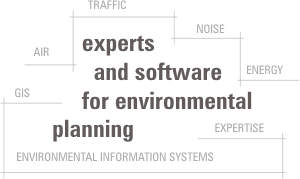



| Quick
link to our products
IMMIS
|

News in 2020
In this project, port-related traffic movements in Bremerhaven and Bremen will be analysed in order to determine the emissions of greenhouse gases and air pollutants caused by these movements. On this basis, pollutant dispersion in the urban area will then be modelled in order to quantify the contribution of port-related emissions to air pollution with spatial differentiation. The aim of the project is to use scenario calculations to derive measures that reduce the pollution caused by port-related activities in Bremerhaven and Bremen.
The project "Emission and Concentration Modelling in Maritime Transport Chains (MaritIEm)" is carried out jointly by the Institute of Shipping Economics and Logistics (ISL), Bremen, and IVU Umwelt, Freiburg. The project started on 1 June 2020 with a term of three years and it is funded by the Federal Ministry of Transport and Digital Infrastructure within the framework of the Modernity Fund (mFUND) funding scheme.
Available since May 2020:
VDI 3782 Part 7: Environmental meteorology - Determination of the emission from motor vehicles - Air quality
An employee of IVU Umwelt contributed to the standard as a member of the respective working group.
This standard discusses the determination of emissions of air pollutants and greenhouse gases by vehicular traffic, using model calculations based on emission factors and emission models. It takes into account the emissions both of moving and of stationary traffic. First and foremost, this covers exhaust gas emissions, evaporation emissions, and emissions from wear and resuspension. Over and above that, the methodology also allows data to be obtained about energy or fuel consumption. The methods described in this standard address primarily the requirements relating to emission data that are meant to be used as input data for models to calculate the dispersal and chemical conversion of traffic-gererated pollutants in the atmosphere.
The standard has been developed and published by the ‘VDI/DIN-Commission on Air Pollution Prevention (KRdL) - Standards Committee'. VDI, the Association of German Engineers, is a financially independent and politically unaffiliated, non-profit organization of engineers as well as academics in other disciplines, especially in information science, the natural sciences and mathematics.
The final report "Dynamic environmentally sensitive traffic management" was published by the German Federal Highway Research Institute (BASt):
In this project, existing environmentally sensitive traffic management (ETM) systems in Braunschweig, Erfurt, Potsdam and Wittenberg as well as a motorway traffic control system in Styria were selected for detailed investigations.
The study shows that the ETM systems operate reliably and are accepted by public authorities, industry and private road users alike. They help to reduce air pollution and the measures implemented comply with the principle of proportionality.
Based on operational data from the areas subject to investigation, it was possible to systematise and evaluate the effects of measures with regard to threshold values and traffic relocations. Changes in flow of traffic, journey times, emissions, road safety and concentrations were analysed as well. Furthermore, forecasts and levels of compliance were evaluated.
For hot spots with an NO2 annual mean value close to the limit value, the reductions determined for soft measures, such as improving the flow of traffic and controlling the inflow of traffic, are in the single-digit percentage range. In terms of the number of days on which PM10 limit values were exceeded, a reduction of a few days was recorded. Higher rates of reduction can be achieved by stricter threshold values and/or introducing hard measures such as traffic restrictions or driving bans. For hot spots with considerable exceedances of limit values, only hard ETM measures lead to the desired results anyway. The environmentally sensitive approach allows threshold values and effects of measures to be optimised with respect to the targets.
Cost and impact analyses show that the implemented ETM measures have either an overall positive cost-benefit ratio or are at least much more beneficial when comparing a dynamic activation with a permanent activation.
Recommendations were given to the authorities on the design and use of ETM systems and measures, depending on local boundary conditions.
Download final report (in German, summary in English) ![]()